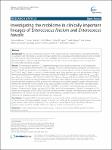Investigating the mobilome in clinically important lineages of Enterococcus faecium and Enterococcus faecalis
Mikalsen, Theresa
Pedersen, Torunn
Willems, Rob
Coque, Teresa M.
Werner, Guido
Sadowy, Ewa
Schaik, Willem van
Jensen, Lars Bogø
Sundsfjord, Arnfinn
Hegstad, Kristin
Background: The success of Enterococcus faecium and E. faecalis evolving as multi-resistant nosocomial pathogens is associated with their ability to acquire and share adaptive traits, including antimicrobial resistance genes encoded by mobile genetic elements (MGEs). Here, we investigate this mobilome in successful hospital associated genetic lineages, E. faecium sequence type (ST)17 (n=10) and ST78 (n=10), E. faecalis ST6 (n=10) and ST40 (n=10) by DNA microarray analyses. Results: The hybridization patterns of 272 representative targets including plasmid backbones (n=85), transposable elements (n=85), resistance determinants (n=67), prophages (n=29) and clustered regularly interspaced short palindromic repeats (CRISPR)-cas sequences (n=6) separated the strains according to species, and for E. faecalis also according to STs. RCR-, Rep_3-, RepA_N- and Inc18-family plasmids were highly prevalent and with the exception of Rep_3, evenly distributed between the species. There was a considerable difference in the replicon profile, with rep17/pRUM, rep2/pRE25, rep14/EFNP1 and rep20/pLG1 dominating in E. faecium and rep9/pCF10, rep2/pRE25 and rep7 in E. faecalis strains. We observed an overall high correlation between the presence and absence of genes coding for resistance towards antibiotics, metals, biocides and their corresponding MGEs as well as their phenotypic antimicrobial susceptibility pattern. Although most IS families were represented in both E. faecalis and E. faecium, specific IS elements within these families were distributed in only one species. The prevalence of IS256-, IS3-, ISL3-, IS200/IS605-, IS110-, IS982- and IS4-transposases was significantly higher in E. faecium than E. faecalis, and that of IS110-, IS982- and IS1182-transposases in E. faecalis ST6 compared to ST40. Notably, the transposases of IS981, ISEfm1 and IS1678 that have only been reported in few enterococcal isolates were well represented in the E. faecium strains. E. faecalis ST40 strains harboured possible functional CRISPR-Cas systems, and still resistance and prophage sequences were generally well represented. Conclusions: The targeted MGEs were highly prevalent among the selected STs, underlining their potential importance in the evolution of hospital-adapted lineages of enterococci. Although the propensity of inter-species horizontal gene transfer (HGT) must be emphasized, the considerable species-specificity of these MGEs indicates a separate vertical evolution of MGEs within each species, and for E. faecalis within each ST.
Dateien zu dieser Publikation
Keine Lizenzangabe

